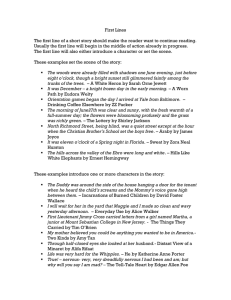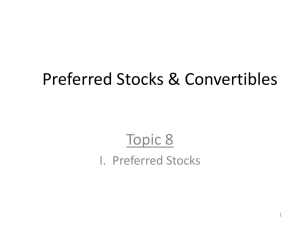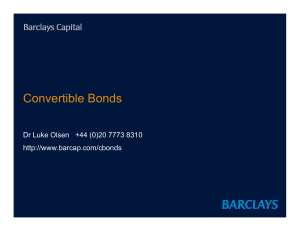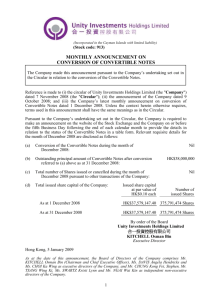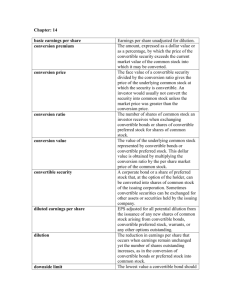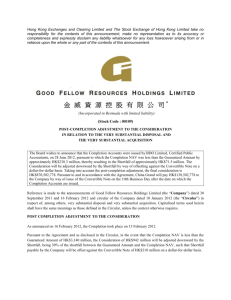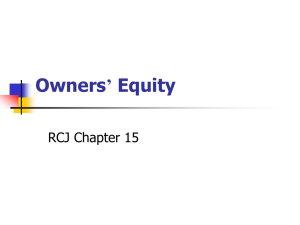Convertible Notes Overview – a Guide for In-House Counsel
advertisement
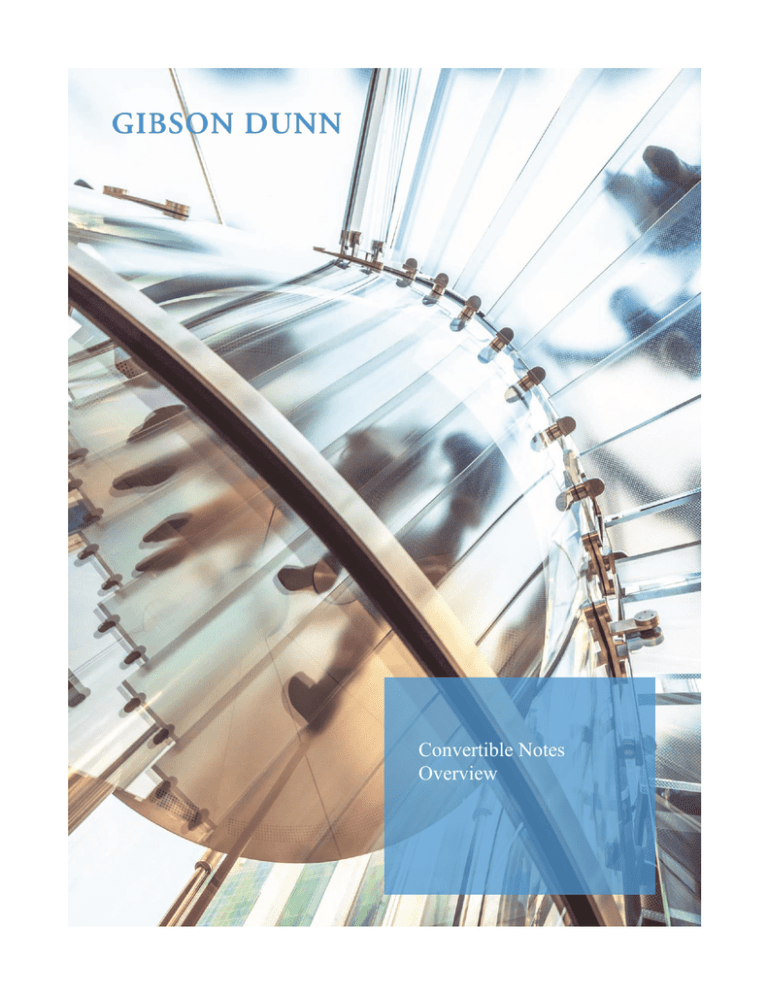
Convertible Notes Overview Preparing for a Smooth IPO Process – a Guide for In-House Counsel Convertible Notes Offerings – An Overview for Issuers Convertible note offerings can be an effective financing tool for issuers. Convertible notes can be a way for issuers to sell equity at a premium, generally offer an issuer lower interest rates than investment grade debt and contain few covenants. The main disadvantages of convertible note offerings are equity dilution and near-term stock price impact and, if the stock price fails to appreciate above the conversion price, potential refinancing risk. What is a convertible note and who invests in them? A convertible note is a debt instrument that is convertible into shares of the issuer or another entity. They offer investors the downside protection of a debt instrument and the upside potential of an equity investment, but in return typically offer lower interest rates than straight debt instruments. Some investors may use convertible bonds as a component of an arbitrage opportunity, for example purchasing a convertible bond while taking a short position in the underlying common stock. This can have the effect of putting downward pressure on an issuer’s stock price at the time of a convertible note offering, particularly if the issuer does not execute a call spread transaction or stock repurchase in connection with the offering. Most convertible bond investors are large institutional investors and hedge funds. How quickly can I execute a convertible note offering? Convertible note offerings can be executed relatively quickly – with as little as one to two weeks advance preparation, in part because they can be effected without SEC registration and without obtaining a rating from a ratings agency. Once launched, a convertible note offering will typically have one or two days of marketing before pricing. In some cases, a convertible note offering will be marketed on an overnight basis or marketed on a wall-cross basis. Who are the participants in a convertible note offering? The major players in a convertible note offering include the issuer, its legal counsel and accountants, and one or more investment banks acting as underwriters or, in the case of a Rule 144A offering, “initial purchasers,” and their counsel. There will also be a trustee. An issuer will generally need internal personnel from finance and/or treasury and legal to devote a fair amount of time to the offering during the preparation period. In addition, the CEO and/or CFO can expect to spend time participating in due diligence sessions and investor calls. Convertible Note Offerings – An Overview for Issuers What are the structuring decisions I will have to make in connection with a convertible note offering? There are a number of principal structuring decisions that an issuer will have to make in connection with a convertible note offering. These include the size of the offering, the maturity date and the settlement method to be used upon conversion of the notes. The settlement options include settlement of the conversion option in shares of common stock (“full physical settlement”), settlement of the conversion option in cash (“cash-convertible”) or settlement of the original principal amount in cash and any conversion premium in shares of common stock (“net-share settlement”). An issuer may also retain the option to settle in cash, shares or a combination of the two (“flexible settlement”). Other structuring decisions include determination of whether there are any conditions that must be met before the notes become convertible, whether, when and at what price the issuer can repurchase the notes at its option after a specified date (a “call”) and whether, when and at what price the investors can require the issuer to repurchase their notes after a specified date (a “put”). The underwriters generally provide guidance on structuring of convertible notes, and the market impact of those decisions. However, structuring decisions can have significant accounting, tax and legal implications, so issuers should coordinate carefully with their accountants, legal counsel and tax advisors regarding the structuring of their convertible note transactions. What other transactions regularly associated with convertible note offerings (such as call spread transactions or stock repurchases)? Convertible note offerings can be conducted on a stand-alone basis, but there are associated transactions that many issuers engage in when they execute a convertible note offering. Many issuers use some or most of the proceeds of a convertible note offering to repurchase shares of common stock. These repurchases can be effected in negotiated transactions, on the open market or through an accelerated share repurchase program with an investment bank. Many issuers also enter into derivative transactions with an investment bank, often referred to as a “call option overlay” or “call spread transaction” to increase the effective conversion premium and reduce the effective dilution of the convertible note offering. These transactions may also help mitigate the downward pressure on an issuer’s stock price immediately after a convertible note offering that may result from short sales by investors purchasing convertible notes in the offering. The underwriters of the convertible note offering are generally the counterparties in an accelerated share repurchase program or a “call option overlay” or “call spread transaction,” but issuers may choose to use different investment banks as counterparties. Are convertible note offerings registered with the SEC? Convertible note offerings can be conducted as registered offerings or as unregistered private offerings under Rule 144A under the Securities Act of 1933, as amended (the “Securities Act”). Most issuers seeking to repurchase shares of common stock at the time of their convertible note offering will offer their notes under Rule 144A in order to avoid regulatory issues under Regulation M. Relying on Rule 144A would also minimize delay in the event the issuer does not have an effective shelf registration statement on file with the SEC and the issuer is not a well-known seasoned issuer (or “WKSI”). Rule 144A requires that the conversion price of the convertible notes be at least 10% above the market value of the underlying shares, but the market generally supports premiums in excess of 10% over the market price of the underlying shares and so this is not usually an issue. Convertible Note Offerings – An Overview for Issuers 2 Do I need shareholder approval to issue shares in a convertible note offering? The New York Stock Exchange (“NYSE”) and the Nasdaq Stock Market (“Nasdaq”) each have rules requiring stockholder approval for issuances of shares representing more than 20% of an issuer’s outstanding shares, with certain exceptions. For most convertible notes offerings, the offering will fall into an exception under the NYSE and Nasdaq shareholder approval rules for offerings of securities at a price of at least the higher of book or market value (in the case of the NYSE, the consideration for the issuance must be for cash in order to take advantage of this exception). Until recently, the NYSE and Nasdaq both took the position that this exception was available only for notes settled using full physical settlement (i.e., settling entirely in shares) and was not available in the case of net-share settlement or flexible settlement. Both NYSE and Nasdaq have changed their position on this topic, and now net-share or flexibly settled 1 convertible notes may take advantage of this exception. Many outstanding convertible notes include caps on the number of shares that may be issued upon conversion of the notes as a result of this historical interpretation, which may have the effect of increasing the possible cash obligations of the issuer upon settlement. The effect of this change of position on caps in existing convertible notes will depend on the drafting of the cap language. Issuers considering the effect of existing caps should consult with counsel. In the event that a convertible note offering is being conducted in order to finance an acquisition, any shares issued in the convertible note offering may be aggregated with any shares issued in the acquisition to determine if the 20% threshold has been reached. Nasdaq, but not the NYSE, has released a number of interpretive materials on this topic. This issue should be considered well in advance, as the parties may conclude in some cases that it is necessary to request guidance from the relevant exchange. Other shareholder approval events under stock exchange rules, such as transactions that may involve a change of control or, in the case of NYSE, involving sales to a related party, should also be considered for their applicability to the offering. What will I need to do to execute a convertible note offering? Documentation: Documentation for a convertible note offering consists primarily of an offering document (either a prospectus or a 144A offering memorandum), an underwriting or purchase agreement, an indenture, an accountant’s comfort letter, opinions of legal counsel and officers’ certificates. In addition, the issuer and its officers and directors typically agree to lock-up arrangements. Generally the underwriters will prepare the “description of notes” to be included in the offering document, as well as the purchase agreement and the indenture. Negotiation of the terms of the notes is typically done based on the “description of notes” before the indenture is prepared and negotiated. There will also be agreements in connection with any accelerated share repurchases or derivative transactions. Due Diligence: The underwriters and both issuer and underwriters’ counsel will conduct due diligence on the issuer prior to launch of the offering. Often this will involve one or two business/financial presentations from senior management of the issuer and legal due diligence. Legal due diligence generally involves review of board materials and minutes, material contracts, 1 See our post on this topic entitled “NASDAQ Issues FAQ Relaxing Historical Position on Net Share Settled Convertible Securities” at http://www.securitiesregulationmonitor.com/Lists/Posts/Post.aspx?ID=246 Convertible Note Offerings – An Overview for Issuers 3 material litigation matters and other areas material to the issuer. Some topics may be covered by discussions with the relevant employees of the issuer rather than extensive document review (for example, intellectual property, environmental, compliance and tax matters are often covered by telephonic due diligence). Material non-public information: In connection with a convertible note offering, as with any offering of securities, an issuer will need to consider whether it is in possession of material nonpublic information. Depending on the timing of the offering, the issuer may need to consider updating guidance or releasing estimated results for the most recent quarter (often referred to as “flash numbers”). Board approvals. Convertible note offerings require approval of an issuer’s board of directors. Under Delaware law, the board of directors may delegate final approval of the pricing terms of a convertible note offering to a pricing committee of the board or to management. In the event that the board delegates the final approval to management, issuers should take care to ensure that the delegation resolution contains the parameters required by Section 152 of the Delaware General Corporation Law. Issuers that are not incorporated in Delaware should review their state corporation laws to determine what level of delegation is permitted. If the issuer is filing a registration statement in connection with the offering, board approval and signatures will also be required. Investor Presentation: Issuers and their underwriters generally work with an existing investor presentation to create a deck for the offering. The CEO and CFO, or other appropriate person from senior management, will generally engage in calls with investors during the marketing period. Are my communications limited during the offering period for convertible notes? Issuers can generally continue to communicate regarding their business in the ordinary course of business, but will need to take care regarding communications that may be considered to be part of the offering (for example, investor conferences). Issuers should discuss communications protocols with counsel in advance of the offering. Will I need to file a resale registration statement if I issue convertible notes in a Rule 144A offering? No, issuers generally are not required to file resale registration statements with respect to convertible notes issued in a Rule 144A offering, or the underlying shares. Generally, the indenture for the notes will require the issuer to take steps to allow holders of the notes to take advantage of the right to sell under Rule 144, and impose penalties if the company fails to take these steps. One year after the offering, a company may remove the restrictive legend from the convertible notes, and the notes can then be freely sold under Rule 144. Do convertible notes generally include restrictive covenants? Convertible notes generally do not include any significant operating or financial covenants. Convertible Note Offerings – An Overview for Issuers 4 What types of events typically trigger anti-dilution adjustments under convertible notes? The initial conversion rate of convertible notes is subject to adjustment in certain circumstances. These circumstances generally include payment of dividends by the issuer (whether in cash or shares of common stock), other distributions to holders of the issuer’s common stock (including rights, options, warrants, indebtedness or other assets), spin-offs and payments by the issuer in a tender or exchange offer in respect of the issuer’s common stock. What events of default are included in convertible notes? Typical events of default for convertible notes include failure to pay interest or principal, failure to comply with conversion obligations, failure to give required notice of fundamental changes, failure to comply with other covenants and events of bankruptcy or insolvency of the issuer. Many convertible notes also include a “cross-default” provision, pursuant to which a default by the issuer on other indebtedness above a specified amount would also result in a default under the convertible notes. Do convertible notes limit an issuer’s ability to engage in a change of control? While convertible notes do not generally include provisions that would prevent a change of control, they do generally include certain provisions regarding the treatment of the notes in a change of control or other fundamental change to the issuer. Even if the convertible notes are not convertible at the time of a fundamental change, they generally will become convertible in connection with the fundamental change. Convertible notes typically include a “make-whole” provision, which provides that holders will receive an increased number of shares upon conversion of the notes in connection with a fundamental change transaction (the exact amount of the increase is determined based on the date of the fundamental change and the price at which it is executed). This is designed to compensate the holder for the loss of the option value of the convertible note. Convertible notes generally also permit the holders to require the issuer to repurchase the notes in the event of a fundamental change transaction. These provisions can add substantially to the expense associated with a change of control. In addition to including a change of control, fundamental change events often include dissolution or liquidation of the issuer and other important events, such as delisting of the issuer’s common stock from a national securities exchange. For both the make-whole provisions and the holders “put” right, a change of control is generally defined to exclude transactions in which the issuer’s shareholders will receive consideration consisting almost entirely of shares listed on the NYSE or Nasdaq. In the event of a reclassification, business combination or asset sale, if any convertible notes remain outstanding after the event, to the extent shares of the issuer’s common stock would have been be deliverable upon conversion of the notes prior to the transaction, the notes will generally become convertible into the form of consideration that was payable to the holders of the issuer’s common stock in the transaction. In addition, convertible notes also generally include a provision preventing an issuer from engaging in a merger or sale of all or substantially all of its assets unless the surviving person is a corporation organized under the laws of the United States, a state of the United States or the District of Columbia, the surviving person assumes all obligations under the notes and the indenture and, after giving effect to the transaction, there is no event of default, or event that would become an event of default, under the indenture. Convertible Note Offerings – An Overview for Issuers 5 How might outstanding convertible notes affect an issuer who wants to engage in a spinoff transaction? In the event that an issuer engages in a spin-off transaction, it will need to carefully evaluate the proposed structure of the spin-off under the terms of any outstanding convertible notes. The provisions that will need to be evaluated in connection with a spin-off include anti-dilution adjustments, the fundamental change provisions and the successor obligor provisions. How will convertible notes affect an issuer’s ability to issue equity in the future? Except in the narrow circumstances triggering anti-dilution adjustments, an outstanding issue of convertible notes generally will not affect an issuer’s ability to issue equity in the future. For example, future underwritten public offerings, the issuance of equity as acquisition consideration and the issuance of equity for compensation purposes would not typically be restricted by, or trigger anti-dilution adjustments under, convertible notes issued in an underwritten or Rule 144A offering. © 2015 Gibson, Dunn & Crutcher LLP. Updated 12/10/15 Gibson Dunn & Crutcher LLP is providing these materials for general informational purposes only. These materials are not intended to constitute, and do not constitute, legal advice and should not be used or relied upon as legal advice. These materials were not created or designed to address the unique facts or circumstances that may arise in any specific instance. Because the law changes constantly, these materials may not indicate the current state of the law. Nothing in these materials predicts or guarantees any future results or outcomes. These materials are not intended to create, nor do they create, either an actual or prospective attorney-client relationship. Likewise, sending email or other material to an attorney at Gibson Dunn about these materials will not create any attorney-client relationship. Do not send us confidential information until you speak with one of our attorneys and receive authorization to do so. Convertible Note Offerings – An Overview for Issuers 6
